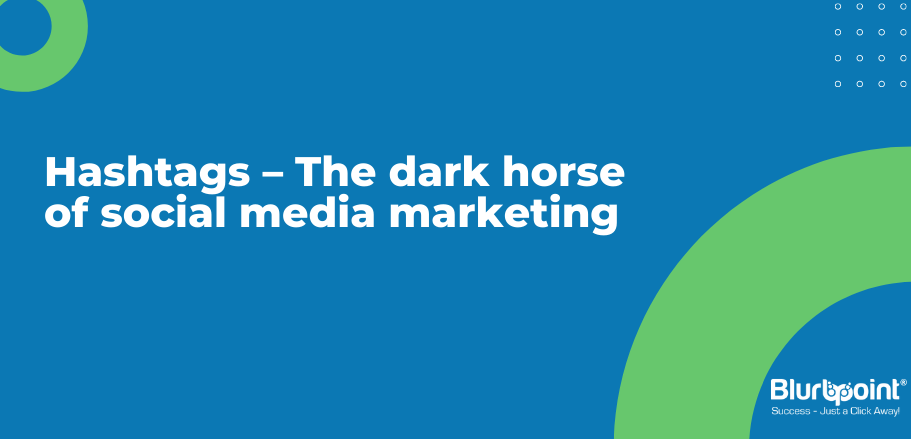GET A FREE CONSULTATION



Posted by Monish Vora
December 28, 2013
The # is enjoying its moment. It is no longer considered a number sign or a mere pound. It has reincarnated on social media and how!
With a completely new identity – hashtag or #tag, it has found its place in all places that are non-digital. There are hashtags at all places that have social media. In simple terms, a hashtag is a convenient way for people to categorize, locate and join conversations on a particular topic. All thanks to Twitter for giving this lowly pound a completely new role on the social web. The hashtag is used to highlight topics or keywords and could be placed anywhere within a post.
One of the greatest advantages provided by social media is that it has the ability to reach a large number of people. Using the hashtag, one could spread the brand, get their message out and take advantage of the popular trends. The term hashtag refers to the topics that a # symbol contains. Some hashtags are only single words (#medicine), while some are multiple words tied together (#ask4more). It’s similar to an index of a book with many chapters. You would go to the index page to search for a particular topic, let’s say George Washington. Social media’s index page is the hashtag, which could be used as #GeorgeWashinton to find all the posts and tweets related.
Let’s have a quick look into the history of hashtags and check out how it has evolved to be such a hit amongst the users throughout all the social media platforms.
• 2007: After being proposed for the first time on Twitter, the hashtags were used with #sandiegofire during the wildfire in California.
• 2009: Twitter now accepts hashtags by linking anything preceded with the # symbol.
• 2011: Audi premiered its first Super Bowl commercial with the help of the hashtag. In the same year, Instagram added hashtag support. Incidentally, even Google+ started linking hashtags in posts.
• 2013: Flickr started supporting hashtags in March. By the end of June, even Facebook started supporting hashtags.
Regardless of how they started, hashtags have now become an essential part of marketing on social media and if used properly, they could help in building a community, grow the following and impart vital points within your own posts.
• More than 70% of users use hashtags on their mobile
• Only 30% use the hashtag on their PC’s or laptops
• Chances of the tweets being re-tweeted are 55% more if they have a hashtag.
• More than 50% of users would share hashtags more often if they knew there were some special promotional offers.
Typing a relevant hashtag into your content will help your targeted readers find your given information, although they aren’t following you. Using the right hashtag is the key to success on the social web as there are millions of hashtags being circulated in a single day.
If you are visiting an event and aren’t sure about the venue, the organizers would have designated a hashtag for all those who would be becoming. Look on the literature or the events web page to get the right hashtag.
The best way to find the right hashtag is to test the term out. Type it into the search box of the social media website and if it is in use, you will get a list of all related posts. It’s the thumb rule that the larger the list, the more popular the hashtag is.
Like any other marketing effort, the hashtag needs to be promoted with a well-planned strategy. Use it at all those places where your brand is being mentioned. Put it on your website, on the promotional materials of your company. All those tweets that use the hashtag, should be retweeted and invite the targeted users to submit their suggestions or experiences with your firm.
Starting a hashtag strategy from scratch would require a continuous and consistent effort. Although there are instances of hashtags going viral instantly, there still goes a lot of work in maintaining the top slot for the hashtag.
• Don’t use your brand/company name: Use those hashtags that your targeted visitors would be actually searching. Your posts already bear the company name and other information. So, it means you only have to optimize a better social media strategy, than simply wasting time hashtagging the posts with your brand name.
• Don’t overdo the hashtagging: Use only those that are relevant to the content that you are posting. The worst thing that you do to your content is to overstuff it with hashtags and with those that are not relevant.
• Be specific: Don’t go off the track while determining the hashtag. The content meant for those looking for a bed will only look for #bed rather than the more generic #furniture.
• Be consistent on all platforms: Whether you are posting on Facebook, Twitter, Instagram or Google Plus, make sure that you are doing it regularly and consistently.
Hashtags are the most unique concept of social media. The best part about this is that it wasn’t started by a company. As the story goes, a group of users got it all started. The suggestions here will hopefully improve the results that you have been getting with your hashtags. Though there is a lot more to be understood, these are the most basic things that one could consider and experiment and measure the differences it brings about. Before creating content, make sure that you research the best hashtags available based on your industry so that you could reap the maximum benefits from it. If you are an SEO service provider, you should convey to your client to use hashtags on their business social media account, so that it reflects in your SEO effort as well.